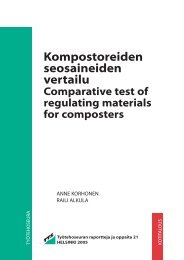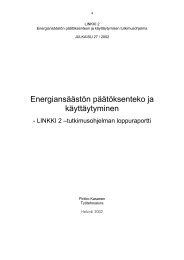Koko raportti pdf-muodossa - TTS
Koko raportti pdf-muodossa - TTS
Koko raportti pdf-muodossa - TTS
You also want an ePaper? Increase the reach of your titles
YUMPU automatically turns print PDFs into web optimized ePapers that Google loves.
10AbstractThe realisation of the commercialisation of the energy efficient technology developedduring the RAKET -research programme in 1993-1998 has been studied with the aid ofexamples of the high performance products. The role of the high performance technologyfor the business can be discovered from the phases of the product examples and theirmarkets before and after the RAKET -research programme.High performance windows and heat pumps were selected to stand for the somewhatmature phase of the R&D of the energy efficient technology. The energy storing basedon the phase change and the air heating device for fireplaces were picked in order tostudy the newcomers in the high performance energy technology business. Thus, newproducts for the portfolio of well established companies, and products from the pioneeringSMs were in the sample. As an example of immaterial production a system developmentfor air heating was studied.Information on factors influencing on commercialisation was gathered from industrialpartners and researchers using various methods: interview study, story telling methodfor tracing the R&D history of the products, literature review and questionnaire. Proposalfor action on promoting the commercialisation of the energy efficient technologywas composed from the researchers' and industrial management's argumentation.The approach to the R&D work during the RAKET -research projects was rathertechnology push than market pull, although the commercialisation was all the time inmind. The research was important for the industry, because that after the industry had anew technically competitive RAKET -product. Still, R&D -projects were needed foreffective production methods. Projects for commercialisation followed in manycompanies. Some had problems with commercialisation, and almost everyone reporteddifficulties in reaching the turbulent growing market phase.Professional building developers and municipal organisations have the best chances forbig energy savings. Their interest towards energy efficient solutions was non-existent.Besides, a certain portion of home builders, consumers and housing associations wereready to buy energy efficient technology, and this trend is increasing.Positive attitudes, ecological awareness and low operating costs were favouring the energyefficient solutions. Among other things, the information has been considered to bea powerful tool for affecting the consumers and increase demand for energy efficiency,which further on will change the attitudes within the construction industry more positivetowards high performance technology. Part of the RAKET -research programme'sresults are not commercialised. This is quite general situation after the R&D of innovations- especially radical innovations such as energy efficient products. The study revealedseveral factors for reasoning this type of situation starting from the conflictingtargets of the research publishing and the international rules on standardisation to theneed of holistic view on indoor and energy technology, lacking R&D resources and badpersonal connection between key actors in the field.Due to the commercially unsuccessful R&D -project a huge energy saving potential inthe ready made unused innovations in the field exists.
















